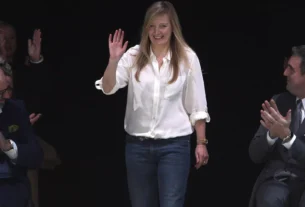In a high-profile leadership shift, Kering, the French luxury conglomerate, has named former Louis Vuitton executive Jean-Pierre Charbin as the new chief of Gucci. This appointment comes as part of Kering’s overarching strategy to rejuvenate its marquee brand, Gucci, which has been a cultural and economic cornerstone within the luxury industry for decades. Known for its unique blend of Italian craftsmanship and contemporary fashion statements, Gucci’s current evolution aligns with Kering’s vision of brand renewal to maintain its competitive edge in the global luxury sector.
The new appointment is significant not only because of Charbin’s history with one of Gucci’s primary competitors, Louis Vuitton, but also because it signals Kering’s intent to recast Gucci’s identity to resonate with a changing consumer base. Charbin’s years of experience in managing luxury brands on a global scale make him well-suited to lead Gucci through this transition. With a clear understanding of the modern luxury landscape, Charbin’s leadership is expected to steer Gucci toward a redefined era of growth, ensuring it remains at the forefront of high fashion and luxury innovation.
Gucci’s Recent Journey and Emerging Challenges
Founded in Florence in 1921, Gucci has long been a hallmark of Italian elegance, synonymous with exquisite leather goods, intricate designs, and a bold approach to luxury. Under the previous leadership of Marco Bizzarri and Creative Director Alessandro Michele, Gucci experienced a renaissance that included dramatic and vibrant designs, drawing an enthusiastic response from younger consumers worldwide. However, after years of exponential growth, Gucci has faced increasing competition from brands like Louis Vuitton, Dior, and Chanel, which have gained significant traction among luxury buyers, particularly in emerging markets.
The brand has also seen its momentum slow as luxury buyers pivot toward more exclusive, understated designs and an emphasis on digital innovation. In response, Kering has taken proactive steps, with Charbin’s appointment marking a decisive moment in Gucci’s journey. Kering’s strategic plan is to renew Gucci’s appeal among traditional luxury consumers while capitalizing on the evolving preferences of younger generations. By leveraging Charbin’s leadership, Gucci aims to strengthen its brand identity and expand its appeal within an increasingly competitive market.
Who is Jean-Pierre Charbin? An Industry Veteran with a Vision
Jean-Pierre Charbin’s extensive background in luxury brand management positions him as an ideal choice to lead Gucci. During his tenure at Louis Vuitton, Charbin held various senior positions, particularly in areas focused on brand innovation, operational management, and international expansion. With a blend of operational expertise and creative insight, Charbin developed a reputation as a strategic thinker who could balance brand integrity with a forward-looking approach. His notable achievements at Louis Vuitton included the successful rollout of new product lines, overseeing major marketing campaigns, and implementing strategies that expanded Louis Vuitton’s presence in high-growth regions.
Charbin’s expertise is further distinguished by his focus on consumer engagement and digital innovation, areas that are increasingly critical for luxury brands. His familiarity with the complexities of brand positioning, global expansion, and digital commerce will serve Gucci as it seeks to enhance its omnichannel strategy. With Kering’s focus on revitalizing Gucci, Charbin’s approach is expected to bring about a balanced blend of Gucci’s Italian heritage and a contemporary brand vision that resonates globally.
Key Priorities for Gucci Under Charbin’s Leadership
As Charbin steps into his role, Kering has laid out clear objectives that align with Gucci’s long-term goals: reimagining the brand’s identity, bolstering digital engagement, and expanding into high-growth markets. Charbin’s initial focus will likely involve a deep analysis of Gucci’s current positioning and a strategic revamp to ensure sustained growth. Below are some of the key areas expected to define Gucci’s trajectory under Charbin:
1. Revitalizing Gucci’s Iconic Brand Identity
Gucci has consistently leveraged its Italian heritage and bold design choices to stand out in the luxury market. Yet, recent trends indicate a shift towards more minimalist, refined aesthetics in luxury fashion. Charbin’s challenge will be to strike a balance between Gucci’s distinct style and evolving consumer preferences. With his background at Louis Vuitton, Charbin is expected to craft a brand identity that emphasizes both exclusivity and accessibility, creating an aesthetic that is both luxurious and universally appealing.
This recalibration may include a return to classic Italian elegance, potentially focusing on traditional silhouettes, subtle patterns, and luxurious textures. By offering a more diverse product line that caters to varying tastes, Charbin aims to broaden Gucci’s appeal while preserving the unique elements that have defined the brand.
2. Driving Digital Transformation and E-Commerce Expansion
Digital transformation is a crucial component of Charbin’s strategy for Gucci. The luxury market has increasingly moved online, with digital channels playing a critical role in consumer engagement and sales. Charbin’s proficiency in digital strategy, developed during his time at Louis Vuitton, positions him well to expand Gucci’s e-commerce operations and optimize its online presence.
Charbin’s plan may involve expanding Gucci’s direct-to-consumer model, enhancing the e-commerce platform, and integrating advanced technologies like artificial intelligence to personalize the shopping experience. By improving online product discovery and offering seamless customer service, Gucci aims to make its e-commerce channels an integral part of the luxury experience. Charbin is also expected to work on elevating Gucci’s social media presence, engaging customers with innovative, immersive content that reflects the brand’s evolving ethos.
3. Focusing on Emerging Markets for Sustainable Growth
Expanding Gucci’s presence in high-growth markets like China, Southeast Asia, and the Middle East is another priority for Kering. These regions have witnessed a surge in luxury demand, with affluent consumers increasingly interested in brands that offer exclusivity, heritage, and superior craftsmanship. Charbin’s background in international expansion aligns perfectly with Gucci’s goal of building a strong presence in these regions, positioning the brand for sustainable growth.
To tap into these markets effectively, Gucci may explore new retail formats, such as pop-up stores, brand exhibitions, and exclusive in-store experiences that reflect local culture. Charbin’s focus on these regions is not only about expanding physical presence but also about building relationships with influential local figures and forming strategic partnerships. This approach will allow Gucci to resonate more deeply with these markets, offering products and experiences tailored to local tastes.
Kering’s Broader Strategic Shift in Luxury Management
Charbin’s appointment to Gucci’s leadership role is part of a larger reorganization within Kering, as the group seeks to reinvigorate its entire portfolio. Kering’s portfolio includes a range of luxury brands, each targeting different segments of the global market. By appointing new leaders across Balenciaga, Bottega Veneta, and now Gucci, Kering underscores its commitment to a more dynamic approach to luxury management, embracing change in response to evolving consumer demands.
This broader shift at Kering suggests a proactive strategy, where each brand under its umbrella is tasked with refining its unique appeal and expanding into new areas. Gucci’s new direction under Charbin reflects Kering’s emphasis on balancing heritage with innovation, ensuring each brand within the portfolio grows in alignment with Kering’s global luxury vision.
Implications for the Luxury Fashion Industry
Charbin’s leadership transition has generated significant attention within the industry, sparking discussions about the implications for luxury fashion as a whole. Competitors like Louis Vuitton, Hermès, and Chanel have consistently raised the stakes with exclusive collections, celebrity endorsements, and curated in-store experiences. Gucci’s move to bring in Charbin signals a possible shift toward similar strategies, where limited-edition collections, exclusive collaborations, and personalized shopping experiences play a pivotal role in brand differentiation.
Analysts are optimistic that Charbin’s appointment will enhance Gucci’s standing in the luxury market, and investor sentiment has responded favorably. Gucci represents one of Kering’s most valuable assets, contributing significantly to its overall revenue. A successful leadership transition and a return to strong growth metrics could reinforce Kering’s position as a powerhouse in luxury fashion.
The Future of Gucci Under Charbin’s Leadership
Jean-Pierre Charbin’s appointment opens a new chapter for Gucci, setting the stage for a forward-looking brand strategy that aligns with evolving consumer preferences. With Gucci’s heritage and design legacy, Charbin is expected to take a holistic approach that modernizes the brand’s identity while respecting its Italian roots. His leadership will likely bring a refined vision that incorporates sustainable practices, innovative designs, and exclusive experiences tailored for today’s discerning luxury consumers.
As Gucci embarks on this new era, the brand’s transformation under Charbin will be closely observed by the industry and consumers alike. His track record of success at Louis Vuitton, combined with a clear strategy to elevate Gucci’s appeal, sets the stage for a period of renewed growth and brand prominence. Kering’s strategic decision to appoint Charbin signals a commitment to long-term brand evolution, ensuring that Gucci remains a timeless yet adaptable icon in the luxury world.





